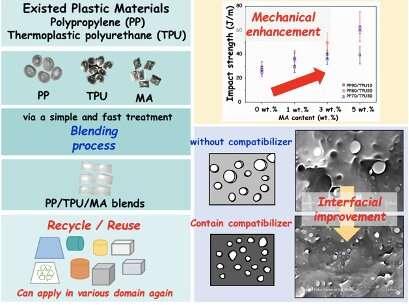A new method for recycling plastics together

Recycling plastic faces several challenges, one of which is recycling different types of plastics together, because they have varying properties, each of which need to be addressed accordingly. Separating and treating each type of plastic adds to the cost of recycling plastic, which reduces the incentive to do so, despite the irreversible and detrimental biological cost of plastics in the environment.
Researchers Tingan Lin and Limin Bao of Shinshu University and their colleague examined the recyclability and sustainable development of thermoplastic materials. Material characteristics were also examined. A simple and fast treatment using a blending process would allow plastics to be useful again, rather than sitting in landfill. Plastics are the most used manmade material after steel and cement and they do not decompose like natural materials. This has led to a lot of unwanted plastic in the environment. Melt or burn are the only ways to eliminate plastic waste, but cause other problems such as toxic fumes and add to global warming. Therefore, a method to melt different plastics together is urgently needed.
Polypropylene is a thermoplastic, which means it is a plastic that can be heated and reshaped. It is used a lot in industry and household applications. The plastics examined in this study, thermoplastic polyurethane and polypropylene have significantly different melting points at 145 C° and 165 C°, so melting them together posed a challenge. To solve this issue, Lin et al. added an appropriate compatibilizer which acts as a go-between for the plastics, which successfully enabled them to be processed together at the same time. The quality of the plastic was not undermined.
The researchers were able to efficiently produce thermoplastic blends using the melt extrusion process and injection molding process. Only a small amount of the compatibilizer, polypropylene grafted maleic anhydride, was needed to do so. This finding would allow for unwanted plastic to be economically valued again and protect wildlife and the environment from further pollution. Professor Bao hopes to continue the study of thermal behaviors to see how they affect the reusability of thermoplastic-based materials.
For more information please read their paper: "Polypropylene/thermoplastic polyurethane blends: mechanical characterizations, recyclability and sustainable development of thermoplastic materials."
More information: Ting An Lin et al, Polypropylene/thermoplastic polyurethane blends: mechanical characterizations, recyclability and sustainable development of thermoplastic materials, Journal of Materials Research and Technology (2020). DOI: 10.1016/j.jmrt.2020.03.056
Provided by Shinshu University




















